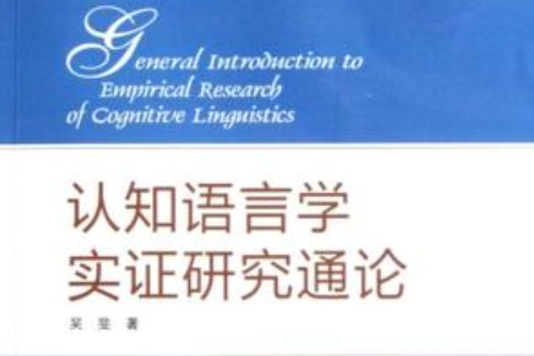《認知語言學實證研究通論》是2012年8月武漢大學出版社出版的圖書,作者是吳斐。
基本介紹
- 書名:認知語言學實證研究通論
- 作者:吳斐
- ISBN:9787307100305
- 頁數:399
- 定價:47.00元
- 出版社:武漢大學出版社
- 出版時間:2012-8
- 裝幀:平裝
內容簡介,圖書目錄,
內容簡介
“認知語言學實證研究通論”介紹認知語言學實證研究的具體方法,全書分為三大部分共十章。第一部分共四章,分別研究聽,說,讀,寫語言技能的實證研究範式。第二部分共四章,主要研究辭彙和語法使用過程中的實證數據統計和模型。第三部分分為兩章,主要研究隱喻和轉喻習得過程中的認知理據。“認知語言學實證研究通論“中的這些實證研究都在認知語言學的理論框架中進行,分別從不同角度揭示了學習者在二語習得過程中所面臨的問題和解決方案。研究結果表明,認知語言學是一門實證性很強的學科,有助於從描寫和解釋兩方面深化第二語言習得研究。這些研究結果具有一定的理論意義,同時對外語教學實踐也具有重要的參考價值。
圖書目錄
Part One Language Skills
Chapter 1 The Effects of Topic Familiarity and English Proficiency on Listening Comprehension
1.1 Information processing and components of listening comprehension
1.1.1 BoLtom-up processing
1.1.2 Top-down processing
1.1.3 Interactional processing
1.1.4 Components of listening comprehension
1.2 Schema theory and its listening comprehension model
1.2.1 Schema theory
1.2.2 Listening comprehension model on schema theory
1.3 Relevance theory and its listening comprehension model
1.3.1 Relvance theory
1.3.2 Listening comprehension model of relevance theory
1.4 Research methodology oflistening comprehension
1.4.1 Research materials and tools
1.4.2 Research questions and hypotheses
1.4.3 The operational definition of variables
1.5 Empirical approaches to listening comprehension
1.5.1 Quantitative statistics and description
1.5.2 Qualitative statistics and description
1.6 Topic familiarity and its effects on listening comprehension
1.6.1 Explanation from schematic perspective
1.6.2 Explanations from relevance theory
1.7 English proficien.cy and its effects on listening comprehension
1.8 Bottom-up and top-down processing in listening comprehension
1.9 The transactional listening comprehension model
Chapter 2 A Cognitive Approach to the Acquisition of Discourse Markers
2.1 The oral characteristics of Discourse Markers
2.2 Two approaches to Discourse Markers
2.2. 1 The coherence-based approach
2.2.2 The relevance-theoretic approach
2.2.3 Differences between the two approaches to Discourse Markers
2.3 Researches on the use and acquisition of Discourse Markers
2.3.1 The use and acquisition of Discourse Markers by native speakers
2.3.2 The use and acquisition of Discourse Markers by I2 learners
2.3.3 The use and acquisition of Discourse Markers by Chinese learners
2.4 Cognitive approaches to Discourse Markers
2.4.1 Schmidt's construct of noticing and the information-processing approach
2.4.3 Relevance Theory and Space Blending Theory: two cognitive theories
2.4.2 VanPattern and input processing
2.4.3 Relevance Theory and Space Blending Theory:two cognitive theories
2.4.4 Integrative study of Relevance Theory and Space Blending Theory
2.5 Research methodology of and empirical approaches to Discourse Markers
2.5.1 Dala in the picture description
2.5.2 Data in the group discussion
2.5.3 Comparison of the two kinds of data
2.5.4 Comparison with the native corpora
5.5.5 Data in the cloze test
2.5.6 Data in the utterance interpretation
2.5.7 Data in the sufficiency of the input
2.5.8 The patterns and implications of Discourse Markers
2.6 Factors contributing to the acquisition of Discourse Markers
2.6.1 Noticing of Discourse Markers
2.6.2 Instruction on Dissourse Makers
2.6.3 Processing of Discoruse Makrers
2.7 Models for the analysis of Discourse Markers
2.7.1 The inferential model of Relevance Theory
2.7.2 Blending models for Discourse Markers' role in utterance interpretation
2.7.3 The separate pragmatic blending model of Discourse Markers
Chapter 3 The Effects of Rhetorical Organization on Reading Comprehension
……
Part Two Morphology and Grammaticalization
Part Three Metaphors and Metonymies
Chapter 1 The Effects of Topic Familiarity and English Proficiency on Listening Comprehension
1.1 Information processing and components of listening comprehension
1.1.1 BoLtom-up processing
1.1.2 Top-down processing
1.1.3 Interactional processing
1.1.4 Components of listening comprehension
1.2 Schema theory and its listening comprehension model
1.2.1 Schema theory
1.2.2 Listening comprehension model on schema theory
1.3 Relevance theory and its listening comprehension model
1.3.1 Relvance theory
1.3.2 Listening comprehension model of relevance theory
1.4 Research methodology oflistening comprehension
1.4.1 Research materials and tools
1.4.2 Research questions and hypotheses
1.4.3 The operational definition of variables
1.5 Empirical approaches to listening comprehension
1.5.1 Quantitative statistics and description
1.5.2 Qualitative statistics and description
1.6 Topic familiarity and its effects on listening comprehension
1.6.1 Explanation from schematic perspective
1.6.2 Explanations from relevance theory
1.7 English proficien.cy and its effects on listening comprehension
1.8 Bottom-up and top-down processing in listening comprehension
1.9 The transactional listening comprehension model
Chapter 2 A Cognitive Approach to the Acquisition of Discourse Markers
2.1 The oral characteristics of Discourse Markers
2.2 Two approaches to Discourse Markers
2.2. 1 The coherence-based approach
2.2.2 The relevance-theoretic approach
2.2.3 Differences between the two approaches to Discourse Markers
2.3 Researches on the use and acquisition of Discourse Markers
2.3.1 The use and acquisition of Discourse Markers by native speakers
2.3.2 The use and acquisition of Discourse Markers by I2 learners
2.3.3 The use and acquisition of Discourse Markers by Chinese learners
2.4 Cognitive approaches to Discourse Markers
2.4.1 Schmidt's construct of noticing and the information-processing approach
2.4.3 Relevance Theory and Space Blending Theory: two cognitive theories
2.4.2 VanPattern and input processing
2.4.3 Relevance Theory and Space Blending Theory:two cognitive theories
2.4.4 Integrative study of Relevance Theory and Space Blending Theory
2.5 Research methodology of and empirical approaches to Discourse Markers
2.5.1 Dala in the picture description
2.5.2 Data in the group discussion
2.5.3 Comparison of the two kinds of data
2.5.4 Comparison with the native corpora
5.5.5 Data in the cloze test
2.5.6 Data in the utterance interpretation
2.5.7 Data in the sufficiency of the input
2.5.8 The patterns and implications of Discourse Markers
2.6 Factors contributing to the acquisition of Discourse Markers
2.6.1 Noticing of Discourse Markers
2.6.2 Instruction on Dissourse Makers
2.6.3 Processing of Discoruse Makrers
2.7 Models for the analysis of Discourse Markers
2.7.1 The inferential model of Relevance Theory
2.7.2 Blending models for Discourse Markers' role in utterance interpretation
2.7.3 The separate pragmatic blending model of Discourse Markers
Chapter 3 The Effects of Rhetorical Organization on Reading Comprehension
……
Part Two Morphology and Grammaticalization
Part Three Metaphors and Metonymies

